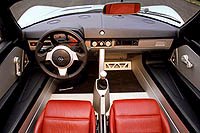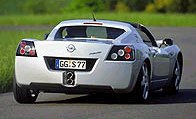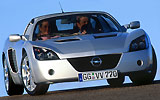 Opel
Speedster (or Vauxhall VX220 in other words) is built and developed
entirely
by Lotus based on Elise. Production takes place in the same production
line as Elise in Hethel which has been enlarged to output a maximum
10,000
cars - around 3000 will be the new Elise, 3000 to 3500 will be the
Speedster.
Therefore Lotus revealed that there is another 3500 spare capacity to
enable
a US-market Speedster to be added. If GM really approves that, it will
be probably badged as a Pontiac. Opel
Speedster (or Vauxhall VX220 in other words) is built and developed
entirely
by Lotus based on Elise. Production takes place in the same production
line as Elise in Hethel which has been enlarged to output a maximum
10,000
cars - around 3000 will be the new Elise, 3000 to 3500 will be the
Speedster.
Therefore Lotus revealed that there is another 3500 spare capacity to
enable
a US-market Speedster to be added. If GM really approves that, it will
be probably badged as a Pontiac.
American journalists thought that might be a modern Fiero. I can’t help feeling sorry with them because they seemed not realise how poor the Fiero was compare with the Speedster. In Chinese saying, "You cannot talk about them in the same day". Think in this way, the Speedster is featherweight sports car having a bit more user-friendliness and a decisively better engine than the Elise. Let us look at its styling first. That is probably the only thing contributed by Opel yet the designer is also a Briton. The intention to distinguish it from Elise is clear, as seen in the aggressive edges and wrap-around head and tail lights which are in contrast to Elise’s organic theme. However, the Elise content is equally clear because the basic aluminium extrusion chassis tub and all the hard points are unaltered. In particular, you’ll see the shape and angle of windscreen mirrors that of the Elise. Dimension wise, the Speedster is more or less identical to Elise although it is 125 kg heavier because of bigger engine and more equipment, such as ABS and a driver’s airbag. Never mind, at 875 kg it is still 100 kg lighter than a tiny MR2 and nearly 400 kg lighter than Honda S2000 !
What differs it from Elise most is the Ecotec 2.2-litre engine coming from Saturn LS and Astra Coupe. The long stroke engine pumps out a remarkable 150 lbft of torque at 4,000 rpm. Most important, 90% of that is available from as low as 1900 rpm. What a contrast to S2000 ! In terms of power, at 147 hp it is not very powerful but is already 27 hp more than the lighter Elise. Therefore the Speedster is as quick as Elise up to 60 mph (i.e., 5.8 sec) and then runs away until it tops 132 mph. Not only quicker than Elise, the Ecotec always feels far more flexible and even smoother, thanks to twin balancer shafts. Gearchange has a longer throw but still accurate.
That’s
how good the car is. Don’t mention Speedster and Fiero in the same day.
|
| The above report was last updated on 28 Mar 2001. All Rights Reserved. |
 How
can it be so light ? the aluminium chassis weighs just 71 kg, the
also-aluminium
Ecotec engine weighs 138 kg, glass-fiber body is lighter than
conventional
steel although build quality is harder to control. The cockpit is "more
luxurious" than Elise but still spartan by any sense. As chassis tub is
the same, you can also see the same narrow cockpit with wide sills.
There
is more black plastic covering the cabin, such as sills, door inner
panels
and the whole dashboard, but the beautiful aluminium tub is still
exposed
on the floor and at transmission tunnel. The thin sports seats are hard
but supportive. A small steering wheel houses an airbag which is the
only
luxurious item over Lotus. Still no electric this or that. No air
conditioning
too. £1200 brings you an optional roof panel, otherwise weather
protection
relies on a manual soft top - call it a cloth may be more suitable.
Normally
it is rolled and stored behind the seats and whenever the driver sense
raining, he’ll stop the car, take out the cloth, unroll it and fix its
two struts to between windscreen pillar and rollover bar. Sounds
complicated
but work quite easy and quick.
How
can it be so light ? the aluminium chassis weighs just 71 kg, the
also-aluminium
Ecotec engine weighs 138 kg, glass-fiber body is lighter than
conventional
steel although build quality is harder to control. The cockpit is "more
luxurious" than Elise but still spartan by any sense. As chassis tub is
the same, you can also see the same narrow cockpit with wide sills.
There
is more black plastic covering the cabin, such as sills, door inner
panels
and the whole dashboard, but the beautiful aluminium tub is still
exposed
on the floor and at transmission tunnel. The thin sports seats are hard
but supportive. A small steering wheel houses an airbag which is the
only
luxurious item over Lotus. Still no electric this or that. No air
conditioning
too. £1200 brings you an optional roof panel, otherwise weather
protection
relies on a manual soft top - call it a cloth may be more suitable.
Normally
it is rolled and stored behind the seats and whenever the driver sense
raining, he’ll stop the car, take out the cloth, unroll it and fix its
two struts to between windscreen pillar and rollover bar. Sounds
complicated
but work quite easy and quick.  To
distinguish it from Elise, Lotus deliberately tuned the chassis to be
less
driver-focused and more user-friendly. Softer dampers leads to
safe-inspiring
understeer into corners. While the Lotus enter a bend with amazing
precision
and alert, the Opel feels stable and grippy but less sharp. Otherwise
there
is little to distinguish between them: same Bridgestone RE 040 tyres,
same
front and rear wheel and tyre size excluding that the front are 17in
instead
of 16 in. The steering is also unassisted (which is only possible for a
car so light at front and having narrow front tyres), delivering very
good
feel and weighting up perfectly on entering a bend. Because of the
suspension
tuning and 225 rear tyres, it is nearly impossible to induce oversteer
unless under severe provocation. In this respect it might be less fun
to
drive than Elise, MR2 and S2000 but its tremendous grip, uncorrupted
steering
and low center of gravity make it more capable and fluent than the
latter
two for most drivers. Besides, few roadsters can deliver a
performance-to-price
ratio so high - at £23,000 it is 5 grand less than the Honda.
To
distinguish it from Elise, Lotus deliberately tuned the chassis to be
less
driver-focused and more user-friendly. Softer dampers leads to
safe-inspiring
understeer into corners. While the Lotus enter a bend with amazing
precision
and alert, the Opel feels stable and grippy but less sharp. Otherwise
there
is little to distinguish between them: same Bridgestone RE 040 tyres,
same
front and rear wheel and tyre size excluding that the front are 17in
instead
of 16 in. The steering is also unassisted (which is only possible for a
car so light at front and having narrow front tyres), delivering very
good
feel and weighting up perfectly on entering a bend. Because of the
suspension
tuning and 225 rear tyres, it is nearly impossible to induce oversteer
unless under severe provocation. In this respect it might be less fun
to
drive than Elise, MR2 and S2000 but its tremendous grip, uncorrupted
steering
and low center of gravity make it more capable and fluent than the
latter
two for most drivers. Besides, few roadsters can deliver a
performance-to-price
ratio so high - at £23,000 it is 5 grand less than the Honda.
 Sales
of Opel Speedster has never met original target. Before the car go to
grave
next year, Opel decided to boost sales by introducing a very fast Turbo
version. In my understanding, this might not boost sales much, but will
definitely boost the image of Opel and benefit the sales of other
mainstream
models. Think about it: the bread-and-butter Opel launches a supercar
capable
of doing 0-60mph in under 5 seconds, how can this not attracting the
attention
of car enthusiasts?
Sales
of Opel Speedster has never met original target. Before the car go to
grave
next year, Opel decided to boost sales by introducing a very fast Turbo
version. In my understanding, this might not boost sales much, but will
definitely boost the image of Opel and benefit the sales of other
mainstream
models. Think about it: the bread-and-butter Opel launches a supercar
capable
of doing 0-60mph in under 5 seconds, how can this not attracting the
attention
of car enthusiasts?
 In
fact, not many cars - regardless of price - can be quicker than the
lightweight
yet powerful Speedster Turbo in the twisty. We always say the standard
Speedster chassis can cope with more power, therefore Lotus just need
to
install slightly stiffer springs and dampers and mildly tweak the
suspension
geometry. Even the size of wheels and tires are unchanged, so is brake.
Other changes are limited to more effective spoilers, bigger side air
intakes
to cool the engine and longer gear ratios to take advantage of the
torquey
engine.
In
fact, not many cars - regardless of price - can be quicker than the
lightweight
yet powerful Speedster Turbo in the twisty. We always say the standard
Speedster chassis can cope with more power, therefore Lotus just need
to
install slightly stiffer springs and dampers and mildly tweak the
suspension
geometry. Even the size of wheels and tires are unchanged, so is brake.
Other changes are limited to more effective spoilers, bigger side air
intakes
to cool the engine and longer gear ratios to take advantage of the
torquey
engine.  The
tuning compensates the weight and power increase and delivers very much
the same characteristic as the normally aspirated Speedster. Ride is
unusually
supple for a sports car. Steering is feelsome. Cornering is stable and
fluent, with mild understeer approaching the limit. It is not as sharp
as Elise, but easier and more comfortable to drive. However, all these
can be applied to the basic Speedster too. What separate them is that
the
Turbo goes faster, much faster. Evo magazine compared it with even a
Ferrari
360 Spider and concluded that the Speedster Turbo handles better -
feels
lighter, smaller and nimbler, more connected to the road and more fun
as
a result.
The
tuning compensates the weight and power increase and delivers very much
the same characteristic as the normally aspirated Speedster. Ride is
unusually
supple for a sports car. Steering is feelsome. Cornering is stable and
fluent, with mild understeer approaching the limit. It is not as sharp
as Elise, but easier and more comfortable to drive. However, all these
can be applied to the basic Speedster too. What separate them is that
the
Turbo goes faster, much faster. Evo magazine compared it with even a
Ferrari
360 Spider and concluded that the Speedster Turbo handles better -
feels
lighter, smaller and nimbler, more connected to the road and more fun
as
a result.